handbrake Alfa Romeo MiTo 2013 Owner handbook (in English)
[x] Cancel search | Manufacturer: ALFA ROMEO, Model Year: 2013, Model line: MiTo, Model: Alfa Romeo MiTo 2013Pages: 312, PDF Size: 11.5 MB
Page 6 of 312

VERY IMPORTANTREFUELLING
Petrol engines: only refuel with unleaded petrol with
octane rating (RON) not less than 95 in compliance with the
European Standard EN228.
Diesel engines: refuel only with diesel fuel conforming to
the European specification EN590. The use of other products
or mixtures may damage the engine beyond repair and
consequently invalidate the warranty, due to the damage
caused.
STARTING THE ENGINE
Petrol engines: make sure that the handbrake is engaged,
set the gear lever to neutral, fully depress the clutch without
depressing the accelerator, then turn the ignition key to AVV
and release it as soon as the engine has started.
Diesel engines: turn the ignition key to MAR and wait for
the warning lights
and
to go out; then turn the
ignition key to AVV and release it as soon as the engine has
started.
PARKING ON FLAMMABLE MATERIAL
The catalytic converter develops high temperatures during
operation. Do not park the car on grass, dry leaves, pine
needles or other flammable material: fire hazard.
RESPECTING THE ENVIRONMENT
The car is fitted with a system that carries out a continuous
diagnosis of the emission-related components in order to help
protect the environment.
ELECTRICAL ACCESSORIES
If after having purchased the car you decide to add
accessories requiring electricity (with the risk of gradually
draining the battery), contact Alfa Romeo Authorized
Services. They can calculate the overall electric requirement
and check that the car's electric system can support the
required load.
CODE card(for versions/markets, where provided)
Keep it in a safe place, not in the car. We recommend that
you always carry the electronic code provided on the CODE
card with you, in case you need to perform an emergency
start.
SCHEDULED SERVICING
Correct maintenance of the car is essential for ensuring that it
maintains its performance and its safety features, its
environmental friendliness and low running costs for a long
time to come.
THE OWNER MANUAL CONTAINS…
...important information, advice and warnings for correct use,
driving safety and maintenance of your car over time.
Particular attention should be paid to information marked
with the following symbols:
(personal safety)
(environmental protection)
(car integrity).
Page 11 of 312

WARNING LIGHTS ON PANELGeneral warnings
The warning lights switch on together with a dedicated message
and/or acoustic signal where appropriate.
These indications are concise and precautionary and, as such, must
not be considered as exhaustive and/or alternative to the information
contained in this Owner Handbook, which you are recommended to
read carefully in all cases.
Always refer to the information in this section in the event of a failure
indication.
Low brake fluid level (red)
Turning the key to the MAR position illuminates the warning light, but it
should switch off after a few seconds.
The warning light (or symbol on the display) comes on when the level
of the brake fluid in the reservoir falls below the minimum level,
possibly due to leaks in the circuit.
The display will show the dedicated message.
Handbrake on (red)Turning the key to the MAR position illuminates the warning light, but it
should switch off after a few seconds.
The warning light (or symbol on the display) switches on when the
handbrake is engaged. If the car is moving the buzzer will also sound.
IMPORTANT If the warning light comes on when the vehicle is in
motion, check that the handbrake is not engaged.
7GETTING TO
KNOW YOUR CARSAFETY
STARTING AND
DRIVING
IN AN EMERGENCY
SERVICING AND
MAINTENANCE
TECHNICAL
SPECIFICATIONS
INDEX
Page 52 of 312

IGNITION DEVICEThe key can be turned to three different positions fig. 19:
❒STOP: engine off, key can be removed, steering column locked.
Some electrical devices (e.g. car radio, central door locking system,
alarm, etc.) are enabled;
❒MAR: driving position. All electrical devices are enabled;
❒AVV: engine start-up.
The ignition switch is fitted with a safety system that requires the
ignition key to be turned back to STOP if the engine does not start,
before the starting operation can be repeated.
If the ignition switch is tampered with (e.g.: attempted
theft), have it checked over by Alfa Romeo Authorized
Services before driving again.
Always remove the key when you leave the car to
prevent someone from accidentally operating the
controls. Remember to engage the handbrake. Engage
1
stgear if the car is parked uphill or reverse if the car is parked
downhill. Never leave children unattended in the car.
STEERING LOCKEngagement
When the key is at STOP, remove the key and turn the steering wheel
until it locks.
Disengagement
Move the steering wheel slightly and turn the ignition key to MAR.
It is absolutely forbidden to carry out any after-market
operation involving steering system or steering column
modifications (e.g.: installation of anti-theft device)
that could badly affect performance and safety, invalidate the
warranty and also result in non-compliance of the car with
type-approval requirements.Never remove the key while the car is moving. The
steering wheel will lock as soon as it is turned. This
holds true for cars being towed as well.
fig. 19
A0J0031
48GETTING TO
KNOW YOUR CAR
SAFETY
STARTING AND
DRIVING
IN AN EMERGENCY
SERVICING AND
MAINTENANCE
TECHNICAL
SPECIFICATIONS
INDEX
Page 107 of 312

VDC SYSTEM (Vehicle Dynamics
Control)This is an electronic system that controls car stability in the event of tyre
grip loss, helping maintain directional control.
The system is capable of recognising potentially dangerous situations
in terms of the stability and intervenes automatically on the brakes in a
differentiated manner for the four wheels in order to provide a
stabilising torque.
The VDC, in turn, includes the following systems:
❒Hill Holder
❒ASR
❒Brake Assist
❒MSR
❒CBC
❒“ELECTRONIC Q2” (“E-Q2”)
❒DSTSYSTEM ACTIVATIONThe VDC system switches on automatically each time the engine is
started and cannot be switched off.SYSTEM INTERVENTIONThis is indicated by the flashing of the
warning light on the
instrument panel, to indicate that the car is in critical stability and grip
conditions.
HILL HOLDER SYSTEMThis system is an integral part of the VDC system and it is provided to
facilitate starting on slopes.
It is activated automatically in the following instances:
❒uphill: vehicle stationary on a road with a gradient higher than 5%,
engine running, brake pedal pressed and gearbox in neutral or
gear (other than reverse) engaged;
❒downhill: vehicle stationary on a road with a gradient higher than
5%, engine running, brake pedal pressed and reverse gear
engaged.
When setting off the VDC system control unit maintains the braking
pressure at the wheels until the engine torque required for departure is
reached or for approximately 2 seconds, allowing your right foot to
be moved easily from the brake pedal to the accelerator.
If the vehicle has not departed after this time, the system will deactivate
automatically by gradually releasing the brake force. A sound may
be heard during this stage: this indicates that the vehicle is about
to move off.
IMPORTANT The Hill Holder system is not a handbrake. Do not leave
the vehicle without having engaged the handbrake, switched off the
engine and engaged a gear.
103GETTING TO
KNOW YOUR CARSAFETY
STARTING AND
DRIVING
IN AN EMERGENCY
SERVICING AND
MAINTENANCE
TECHNICAL
SPECIFICATIONS
INDEX
Page 147 of 312
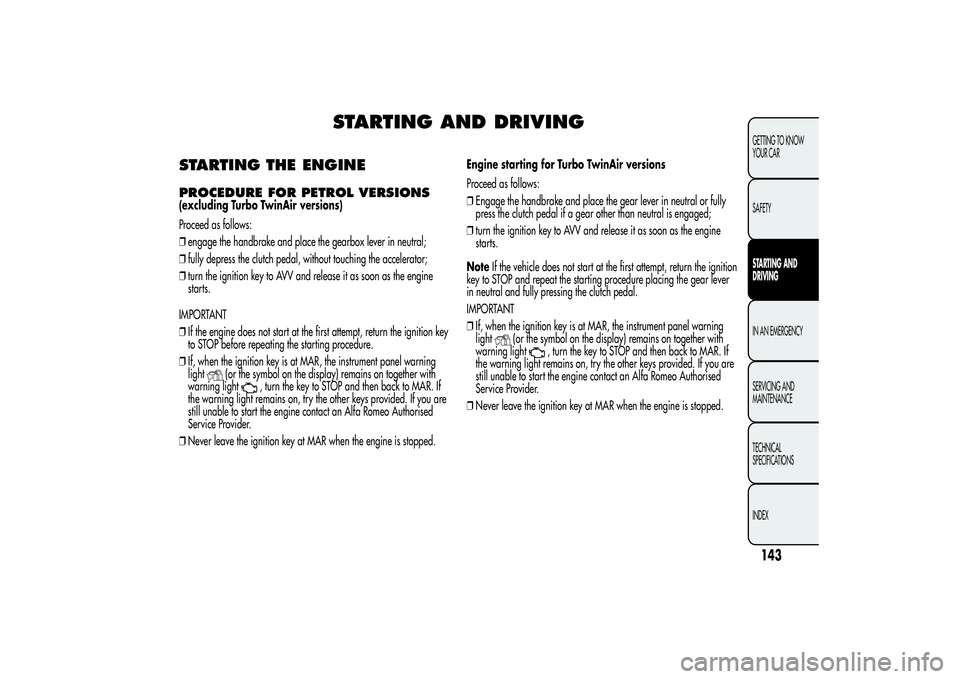
STARTING AND DRIVING
STARTING THE ENGINEPROCEDURE FOR PETROL VERSIONS(excluding Turbo TwinAir versions)
Proceed as follows:
❒engage the handbrake and place the gearbox lever in neutral;
❒fully depress the clutch pedal, without touching the accelerator;
❒turn the ignition key to AVV and release it as soon as the engine
starts.
IMPORTANT
❒If the engine does not start at the first attempt, return the ignition key
to STOP before repeating the starting procedure.
❒If, when the ignition key is at MAR, the instrument panel warning
light
(or the symbol on the display) remains on together with
warning light
, turn the key to STOP and then back to MAR. If
the warning light remains on, try the other keys provided. If you are
still unable to start the engine contact an Alfa Romeo Authorised
Service Provider.
❒Never leave the ignition key at MAR when the engine is stopped.Engine starting for Turbo TwinAir versions
Proceed as follows:
❒Engage the handbrake and place the gear lever in neutral or fully
press the clutch pedal if a gear other than neutral is engaged;
❒turn the ignition key to AVV and release it as soon as the engine
starts.
NoteIf the vehicle does not start at the first attempt, return the ignition
key to STOP and repeat the starting procedure placing the gear lever
in neutral and fully pressing the clutch pedal.
IMPORTANT
❒If, when the ignition key is at MAR, the instrument panel warning
light
(or the symbol on the display) remains on together with
warning light
, turn the key to STOP and then back to MAR. If
the warning light remains on, try the other keys provided. If you are
still unable to start the engine contact an Alfa Romeo Authorised
Service Provider.
❒Never leave the ignition key at MAR when the engine is stopped.
143GETTING TO KNOW
YOUR CAR
SAFETYSTARTING AND
DRIVINGIN AN EMERGENCY
SERVICING AND
MAINTENANCE
TECHNICAL
SPECIFICATIONS
INDEX
Page 148 of 312

PROCEDURE FOR DIESEL VERSIONSProceed as follows:
❒engage the handbrake and place the gearbox lever in neutral;
❒turn the ignition key to MAR-ON: the warning lights
and
(or the symbol on the display) on the instrument panel will
switch on;
❒wait for the warning lights (or the symbol on the display) to switch
off;
❒fully depress the clutch pedal, without touching the accelerator;
❒turn the ignition key to AVV;
warning light switches off.
Waiting too long will waste the heating work carried out by the
glow plugs. Release the key as soon as the engine starts.
If the
warning light flashes for about 1 minute after
starting or during prolonged cranking, this indicates a fault
in the glow plug preheating system. Use the car normally
if the engine starts and go to Alfa Romeo Authorized Services as soon
as possible.
It is dangerous to run the engine in enclosed areas. The
engine takes in oxygen and releases carbon dioxide,
carbon monoxide and other toxic gases.
It is advisable not to demand maximum performance from
your car (e.g. excessive acceleration, long distances at
maximum rpm, excessively intense braking, etc.) when it is
first used.When the engine is off, do not leave the ignition key turned
to MAR to prevent unnecessary electrical consumption from
draining the battery.Remember that the brake servo and electromechanical
power steering are not operational until the engine
has been started, therefore much more effort than
usual is required on the brake pedal and steering wheel.Never start the engine by pushing, towing or driving
downhill. These manoeuvres may damage the catalytic
converter.
144GETTING TO KNOW
YOUR CAR
SAFETYSTARTING AND
DRIVINGIN AN EMERGENCY
SERVICING AND
MAINTENANCE
TECHNICAL
SPECIFICATIONS
INDEX
Page 149 of 312
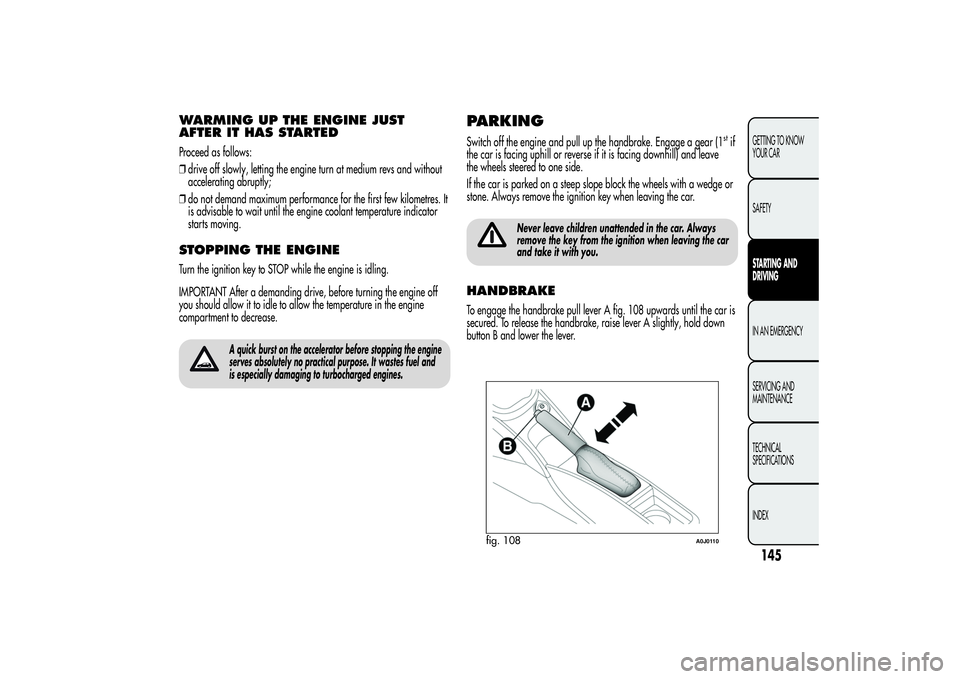
WARMING UP THE ENGINE JUST
AFTER IT HAS STARTEDProceed as follows:
❒drive off slowly, letting the engine turn at medium revs and without
accelerating abruptly;
❒do not demand maximum performance for the first few kilometres. It
is advisable to wait until the engine coolant temperature indicator
starts moving.STOPPING THE ENGINETurn the ignition key to STOP while the engine is idling.
IMPORTANT After a demanding drive, before turning the engine off
you should allow it to idle to allow the temperature in the engine
compartment to decrease.
A quick burst on the accelerator before stopping the engine
serves absolutely no practical purpose. It wastes fuel and
is especially damaging to turbocharged engines.
PARKINGSwitch off the engine and pull up the handbrake. Engage a gear (1
stif
the car is facing uphill or reverse if it is facing downhill) and leave
the wheels steered to one side.
If the car is parked on a steep slope block the wheels with a wedge or
stone. Always remove the ignition key when leaving the car.
Never leave children unattended in the car. Always
remove the key from the ignition when leaving the car
and take it with you.
HANDBRAKETo engage the handbrake pull lever A fig. 108 upwards until the car is
secured. To release the handbrake, raise lever A slightly, hold down
button B and lower the lever.
fig. 108
A0J0110
145GETTING TO KNOW
YOUR CAR
SAFETYSTARTING AND
DRIVINGIN AN EMERGENCY
SERVICING AND
MAINTENANCE
TECHNICAL
SPECIFICATIONS
INDEX
Page 150 of 312
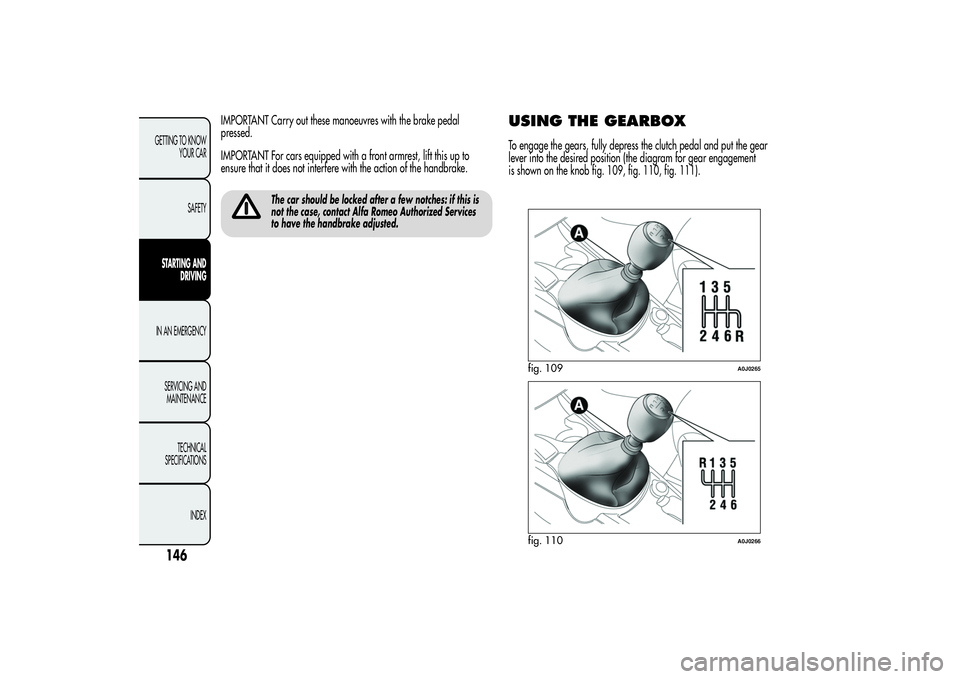
IMPORTANT Carry out these manoeuvres with the brake pedal
pressed.
IMPORTANT For cars equipped with a front armrest, lift this up to
ensure that it does not interfere with the action of the handbrake.
The car should be locked after a few notches: if this is
not the case, contact Alfa Romeo Authorized Services
to have the handbrake adjusted.
USING THE GEARBOXTo engage the gears, fully depress the clutch pedal and put the gear
lever into the desired position (the diagram for gear engagement
is shown on the knob fig. 109, fig. 110, fig. 111).
fig. 109
A0J0265
fig. 110
A0J0266
146GETTING TO KNOW
YOUR CAR
SAFETYSTARTING AND
DRIVINGIN AN EMERGENCY
SERVICING AND
MAINTENANCE
TECHNICAL
SPECIFICATIONS
INDEX
Page 156 of 312
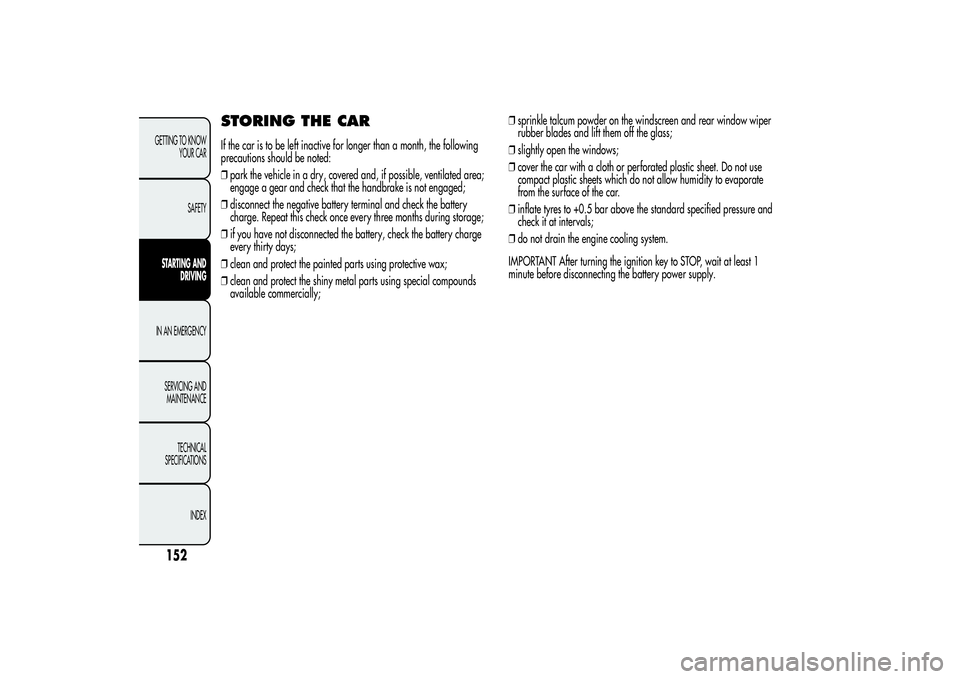
STORING THE CARIf the car is to be left inactive for longer than a month, the following
precautions should be noted:
❒park the vehicle in a dry, covered and, if possible, ventilated area;
engage a gear and check that the handbrake is not engaged;
❒disconnect the negative battery terminal and check the battery
charge. Repeat this check once every three months during storage;
❒if you have not disconnected the battery, check the battery charge
every thirty days;
❒clean and protect the painted parts using protective wax;
❒clean and protect the shiny metal parts using special compounds
available commercially;❒sprinkle talcum powder on the windscreen and rear window wiper
rubber blades and lift them off the glass;
❒slightly open the windows;
❒cover the car with a cloth or perforated plastic sheet. Do not use
compact plastic sheets which do not allow humidity to evaporate
from the surface of the car.
❒inflate tyres to +0.5 bar above the standard specified pressure and
check it at intervals;
❒do not drain the engine cooling system.
IMPORTANT After turning the ignition key to STOP, wait at least 1
minute before disconnecting the battery power supply.
152GETTING TO KNOW
YOUR CAR
SAFETYSTARTING AND
DRIVINGIN AN EMERGENCY
SERVICING AND
MAINTENANCE
TECHNICAL
SPECIFICATIONS
INDEX
Page 160 of 312
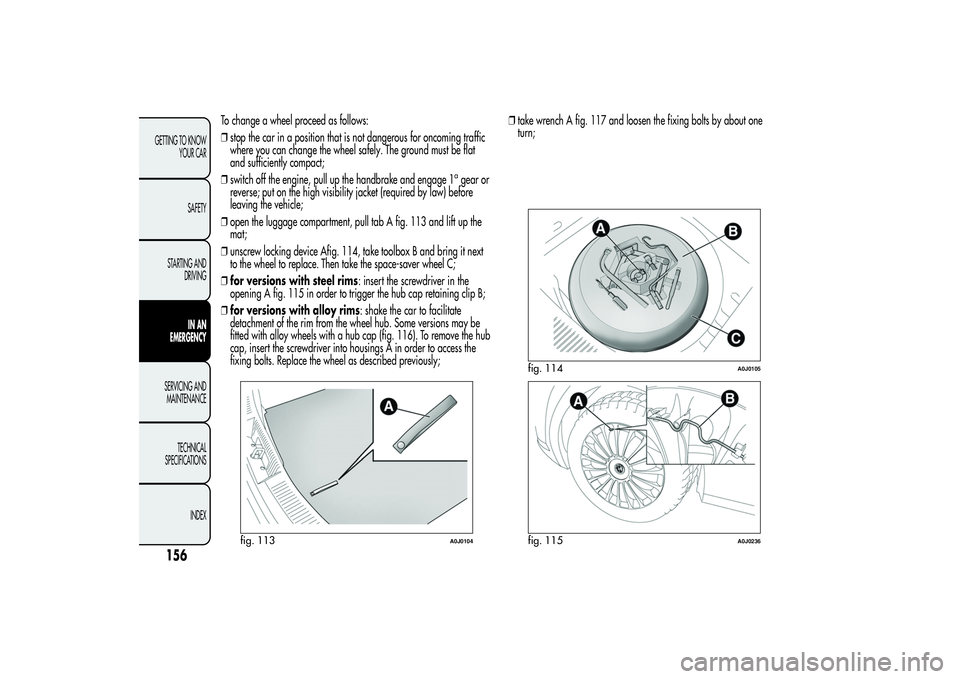
To change a wheel proceed as follows:
❒stop the car in a position that is not dangerous for oncoming traffic
where you can change the wheel safely. The ground must be flat
and sufficiently compact;
❒switch off the engine, pull up the handbrake and engage 1
agear or
reverse; put on the high visibility jacket (required by law) before
leaving the vehicle;
❒open the luggage compartment, pull tab A fig. 113 and lift up the
mat;
❒unscrew locking device Afig. 114, take toolbox B and bring it next
to the wheel to replace. Then take the space-saver wheel C;
❒for versions with steel rims: insert the screwdriver in the
opening A fig. 115 in order to trigger the hub cap retaining clip B;
❒for versions with alloy rims: shake the car to facilitate
detachment of the rim from the wheel hub. Some versions may be
fitted with alloy wheels with a hub cap (fig. 116). To remove the hub
cap, insert the screwdriver into housings A in order to access the
fixing bolts. Replace the wheel as described previously;❒take wrench A fig. 117 and loosen the fixing bolts by about one
turn;
fig. 113
A0J0104
fig. 114
A0J0105
fig. 115
A0J0236
156GETTING TO KNOW
YOUR CAR
SAFETY
STARTING AND
DRIVING
IN AN
EMERGENCY
SERVICING AND
MAINTENANCE
TECHNICAL
SPECIFICATIONS
INDEX